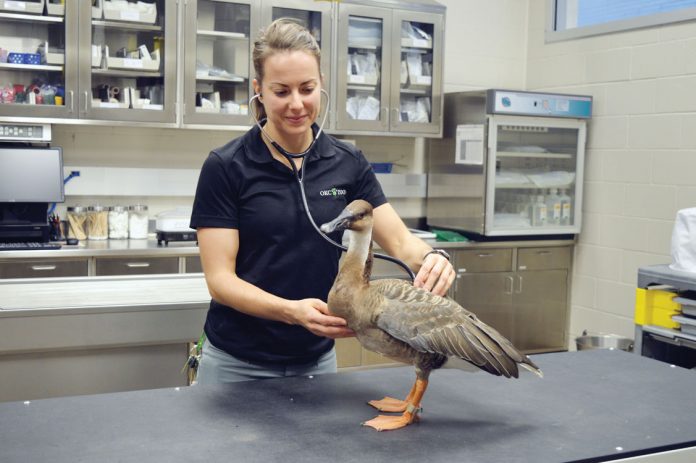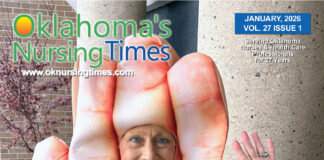
by Traci Chapman – staff writer/photographer
Last week, Julia Jones’ day comprised of taking care of patients – there was Gigi, who was suffering a respiratory issue and Arizona, who needed x-rays. Just like many other nurses, Jones was busy treating her patients, working on preventative health options and working in the lab.
But, Gigi and Arizona are not average patients and Jones is definitely a different kind of nurse, as she treats the swan goose and Texas tortious at the Oklahoma City Zoo.
“This is an amazing place to work, it’s so different every day, and I tell my other nursing friends how special it is,” Jones said. “But, in many ways it’s not all that different from them treating human patients because our animals have many of the same kind of health issues and conditions.”
Jones always knew she wanted to work with animals, she said. Living in Michigan, she first believed she wanted to be a veterinarian – but, after shadowing a vet for a time, she realized that wasn’t what she wanted to do and that she wanted to provide more in-depth care to her patients. That’s when she learned about vet technology/nursing.
The future OKC Zoo nurse would begin with a bachelor’s of science degree in zoology from Michigan State University, followed by an associate’s degree in veterinary technology from Purdue University.
Moving from Michigan to Virginia, Jones worked for about a year in a Waynesboro wildlife center, learning the ropes of veterinary nursing. But, she wanted something different – or, perhaps, more – and she found it in of all places, Oklahoma City.
“I was looking on the website of the Association of Zoo Veterinary Technicians website and saw a position at the Oklahoma City zoo and it just clicked – I knew this was where I wanted to be,” Jones said. “There was just something about it that intrigued me, even before I knew all there was to it.”
That was five years ago, and she has never looked back, said Jones. She landed the vet tech position, becoming one of then two nurses treating OKC Zoo’s about 1,800 residents. At the time Jones and fellow longtime veterinarian nurse Liz McRae more than had their hands full. While their jobs are still varied, busy and even crazy at times, something recently brought their work days – and the level of care they could give – to a whole new level, Jones said.
It was about the time Jones joined OKC Zoo the Kirkpatrick Foundation announced it wanted to bestow a gift on the facility – a $1 million donation to help kick-start an effort to build a new veterinary hospital onsite. That gift was combined with $4.5 million in Oklahoma City tax revenue and another $4.5 million in membership and fundraising fees, making the Joan Kilpatrick Animal Hospital a reality when it opened in 2015.
The new hospital features surgery, radiology and treatment rooms, as well as a laboratory and pharmacy, a commissary that helps staff manage animal dietary needs, quarantine area and an observation deck that allows zoo visitors the chance to see how Jones and her fellow nurses and other medical staff treat their patients and why.
The expanded facility also meant a boost in the zoo’s nursing staff, from two to three as Stephanie Smith joined the team, as well as the addition of veterinary assistant Michael First – a welcome addition to a team that treats everything from aardvarks to zebras.
While many nurses are very specialized – whether it’s labor and delivery, emergency room or even working for a general practitioner, where at least some positions might mean a fairly routine set of responsibilities, Jones and her fellow veterinary nurses are anything but.
“It’s very all encompassing,” she said. “In any one day, we might work in radiology, assist in surgery, work in ICU and ER, we’re working in the lab, completing and updating medical records, working the pharmacy – it’s just a little of everything.” Jones and her fellow nurses also work in more than the new state-of-the-art Kilpatrick facility, she said. Many times, it’s easier to go to the animals than bring them in. That means several “house calls” a week, in addition to the average five patients in the hospital at any given time.
“It’s great the variety of things we do – not just ‘routine’ medical tests and procedures, but also things like watching hormone levels for breeding cycles and viral testing, things like that,” Jones said. “Like my friends who are ‘human’ nurses, we treat everything from turtles with pneumonia, we administer radiographs, just whatever a nurse would do for a human patient, much of that we do for ours.”
Jones said her love for the zoo, her job and patients and her co-workers led her to look at her skills and do even more – prompting Jones to get a part-time position at an emergency room clinic, where she could hone her skills one day a week.
“I knew the ER clinic would give me an opportunity to get my skills to a higher level, to sharpen them, and I want to have the absolute most knowledge and best skills for our patients,” she said.
So, why would a “traditional” nurse consider veterinary nursing?
“It is such an exciting, interesting, challenging job – and, if you love animals, it’s just that much better,” Jones said. “I would encourage anyone even a little bit interested to take the time to explore the field because they won’t ever regret it.”

· HHA – FT
· LPN – FT
· RN – FT
Apply in Person at 7705 S. Walker Ave, OKC, OK 73139 or call (405) 789-2913












